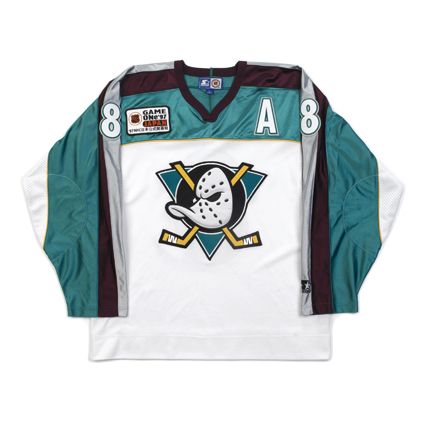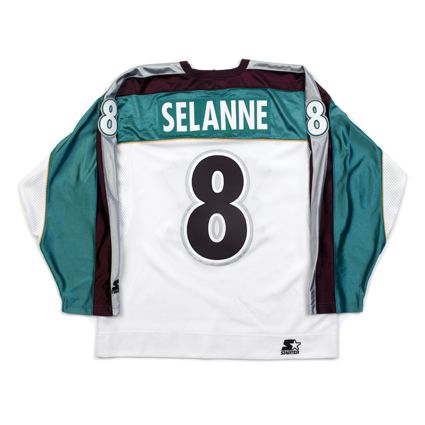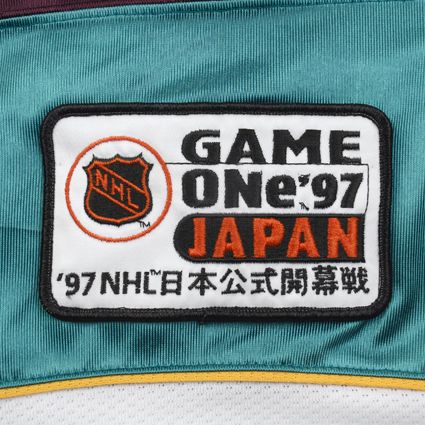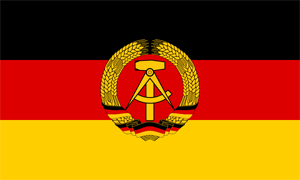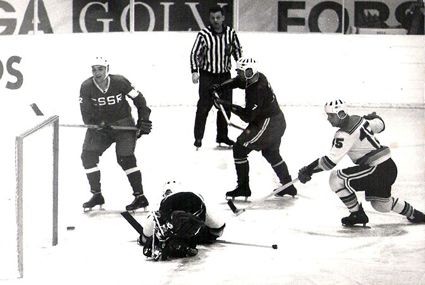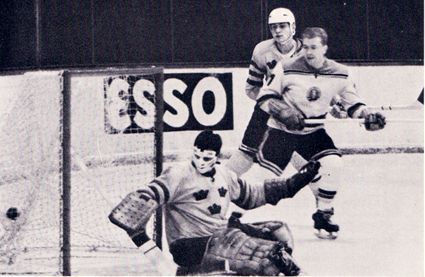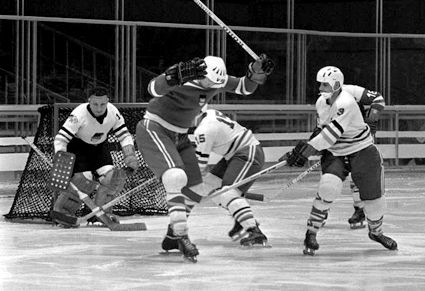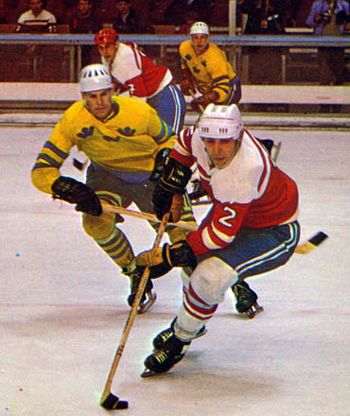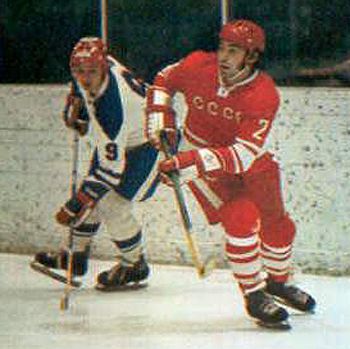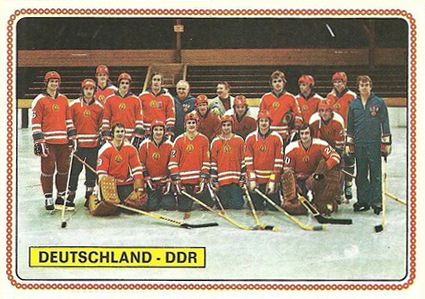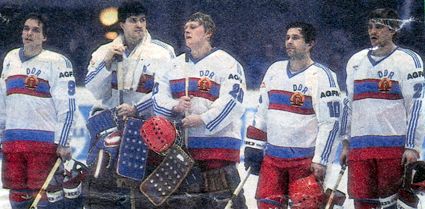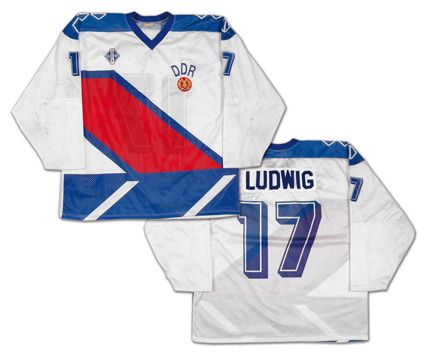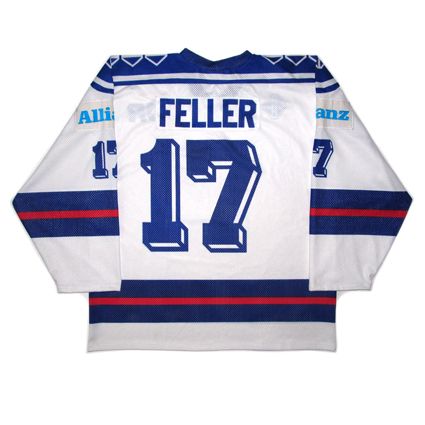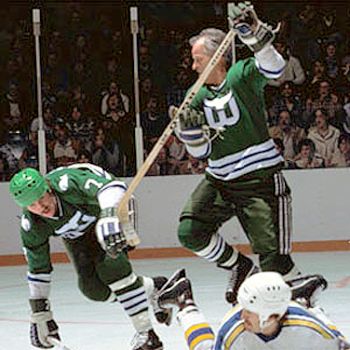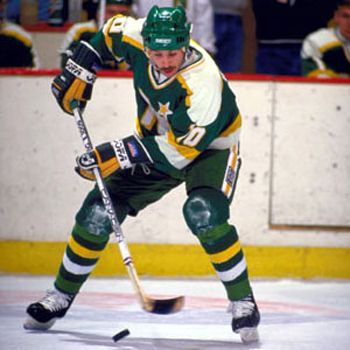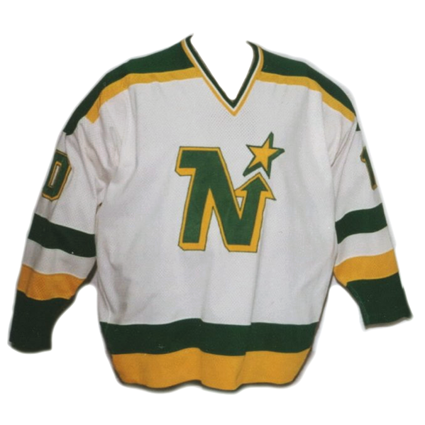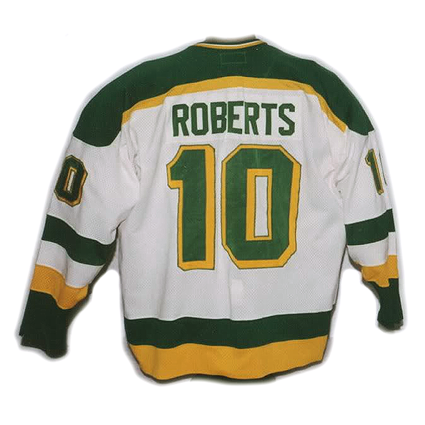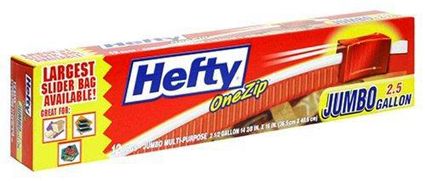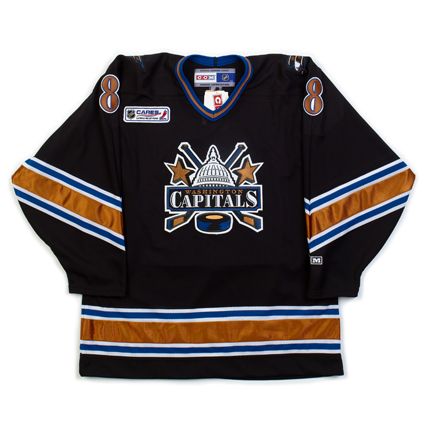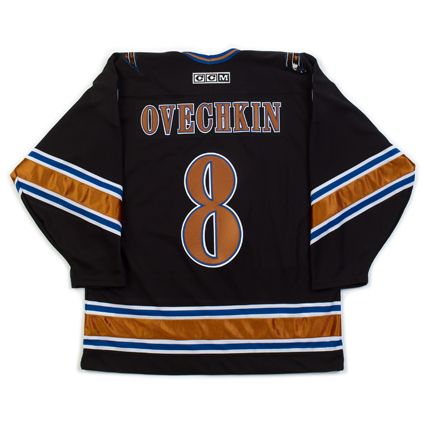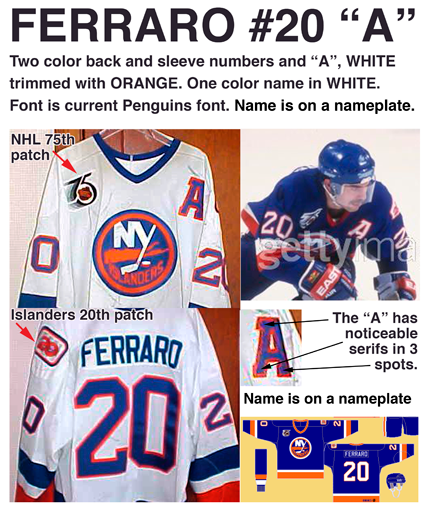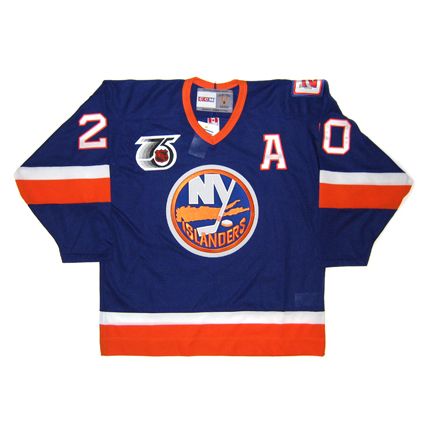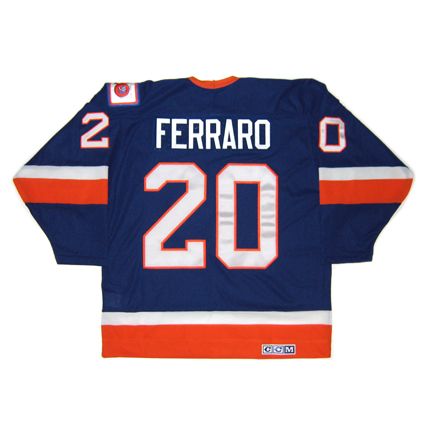Friday, October 4, 2013
1997-98 Mighty Ducks of Anaheim Teemu Selanne Jersey
Today we feature a jersey worn during the first ever regular season games played outside of North America.
While there is a past history of teams playing exhibition or pre-season games, primarily in Europe with one previous instance of games in Japan, for the games to actually count in the regular season standings was something entirely new.
Dubbed NHL Game ONe '97, the NHL season opened on October 3rd and 4th, 1997 with a pair of games held in Tokyo, Japan between the Vancouver Canucks and the Mighty Ducks of Anaheim.
The sold out games were held in the Yoyogi Arena and were part of nearly a week's worth of events which led up to the games, designed to raise the Japanese public's awareness of hockey and increase their interest in the upcoming Winter Olympics, to be held just four months later in Nagano, Japan, that would feature the first wholesale participation of NHL players who were normally unavailable to compete in the Olympics which are held during the middle of the NHL season.
The first game took place on October 3rd, and was won by the Vancouver Canucks and their new captain Mark Messier by a score of 3-2. On a jersey related note, this was the first regular season game for the Canucks new jerseys which featured the Orca logo and their new color scheme featuring blue, which replaced their familiar black and yellow colors.
Scott Walker had the distinction of scoring the first regular season goal outside of North America to open the scoring in the first period, beating the Mighty Ducks goaltender Guy Herbert.
Anaheim evened the score on a goal by Scott Young before Vancouver tied the game on scores from Mark Messier and Pavel Bure. Shawn Antoski got the game winner at 17:22 of the second and the teams played a scoreless third. Kirk McLean got the win and made 32 saves in front of a crowed of 10,500. A side note, the Mighty Ducks Espen Knutsen became the first Norwegian to play in the NHL during this contest.
Anaheim, designated the home team for the second contest, took the opportunity to debut today's featured jersey, their new white alternates.
Teemu Selanne opened the scoring at 7:42 of the first, only to be equalled by Bure at 15:37.
Tomas Sandstrom would put the Mighty Ducks back in front at 5:19 on the power play but Trevor Linden would respond with a power play goal of his own at 18:01 to tie the score at 2-2 heading into the third.
The Mighty Ducks would get the game winning goal from J. J. Daigneault at 13:38 of the third from Sandstrom and Selanne, his second assist of the game to give him points on all three Anaheim goals. Mikhail Shtalenkov got the win for the Mighty Ducks with 25 saves, including holding off a late Vancouver 6-on-4 advantage, as the Canucks were given a power play and then pulled their goaltender McLean for an extra skater.
The NHL would again return to Japan to open the season with a pair of games in 1998 and 2000. The league would not venture overseas to open the season again until 2007 for a pair of games in London. Dubbed "NHL Premiere 2007", they were the first regular season games ever held in Europe.
Last season began with two games in Prague, Czech Republic and another pair in Stockholm, Sweden, while the NHL returned earlier this week to again play four games, two in Helsinki, Finland split by the Chicago Blackhawks and Florida Panthers and again for a pair in Stockholm, Sweden where the St. Louis Blues swept the Detroit Red Wings.
Today's featured jersey is a Starter 1997-98 Mighty Ducks of Anahiem alternate Teemu Selanne jersey as worn on October 4, 1997. This jersey features the NHL Game ONe '97 patch, worn by both the Mighty Ducks and Canucks for their two-game series in Tokyo, Japan to open the 1997-98 NHL season.
This was the debut for the Mighty Ducks new white home alternate, which would also be joined by a jade green version of this jersey used as a road alternate, giving them four jerseys to pick from throughout the 1997-98 season.
No chance to ever find any video of the games in Japan I'm afraid, so let's go off the board with these two commercials featuring Teemu from his native Finland for a change of pace.
Teemu says: "This is my thing. This is what I'm good at."
Labels:
Mighty Ducks of Anaheim,
Selanne Teemu
Thursday, October 3, 2013
1988 East Germany Andreas Ludwig Jersey
After the fall of the Berlin Wall on November 9, 1989, the German Democratic Republic (East Germany) and the Federal Republic of Germany (West Germany) once again became a single, united country for the first time since 1949 with their official reunification on October 3, 1990.
With the division of Germany in the aftermath of World War II into Soviet controlled East Germany and West Germany, which was supported by Great Britian, France and the United States, on October 7, 1949, it necessitated separate national hockey team programs.
With the division of Germany in the aftermath of World War II into Soviet controlled East Germany and West Germany, which was supported by Great Britian, France and the United States, on October 7, 1949, it necessitated separate national hockey team programs.
The flag of the German Democratic Republic,
otherwise known as East Germany
The East Germans made their international debut on January 28, 1951 in a 8-3 loss to Poland. It would take them until 1956 to make their debut at the World Championships, which they did in style, winning the "B" Pool tournament to earn promotion to the Top Division their first time out.
The East Germans were also represented at the 1956 Olympics by the Unified Team of Germany, a single team of athletes which competed at the Summer and Winter Olympics in 1956. However, in the case of the Winter Olympic hockey tournament, the East German and West German teams were not combined into a single representative team, but instead the two sides faced off against each other prior to the Olympics to determine which one team would represent Germany as a whole, so rather than being a unified team, it served the opposite effect in the case of hockey, pitting the two sides against each other!
For 1956, the West Germans won 7-3, leaving the East Germans out of the Games.
In 1957, the World Championships were held in the Soviet Union for the first time, and due to the Soviets occupying Hungary at the time, the United States, Canada, Norway, West Germany, Switzerland and Italy all stayed home in protest. With the lack of several of the favorites, East Germany was able to finish 5th thanks to wins over Japan, Poland and Austria.
Despite their success in 1957, they did not participate in the 1958 World Championships, but returned in 1959 for a 9th place finish. After being drubbed by the Soviet Union, the United States and Norway in the First Round, being outscored 21-6, they held their own in the Consolation Round, beating Poland 5-1, Switzerland 8-0 and Italy 8-6, but lost to West Germany and Norway for a second time.
East Germany was again represented by the Unified Team of Germany at the 1960 Olympics, only as in 1956, the West Germans prevailed in the qualification matches by scores of 5-2 and 5-3 and won the right to represent Germany as a whole.
After not participating in 1961 or 1962, the East Germans became regulars at the World Championships from 1963 on. Facing the might of the hockey powers of the world, the East Germans finished 6th (with a win over Finland and a tie against the United States) in 1963.
East Germany vs Czechoslovakia in 1963
The following year was another Olympic year, and East Germany was again represented by the Unified Team of Germany, but for a third time it was the West Germans who won the right to participate following a 4-3 win in their second game after a 4-4 tie in the first game gave the East Germans hope of participating in the Olympics for the first time.
East Germany next placed 5th (With wins over the United States, Norway and Finland) in the 1965 World Championships, 5th (with wins over Sweden (despite giving up 74 shots on goal!), Poland and Finland) in 1966 and 7th (with a win over West Germany and a tie with the United States) in 1967.
East Germany scoring against Sweden in 1965
For the 1968 Olympics, both East and West Germany competed as separate nations for the first time since the division of Germany. While they had met several times during the World Championships, this would be the only time the two nations would face each other at the Olympics, with the West prevailing by a score of 4-2.
East Germany in their only Olympic meeting against West Germany in 1968
With that loss, the East Germans finished in last place with an 0-7-0 record at the Olympics (which also served as the World Championships in Olympic years) and were relegated to Group B for the 1969 World Championships.
East Germany, wearing red instead of their customary blue,
faces Sweden at the 1968 Olympics
It was at this point in 1969, following their failure at the Olympics, that the East German authorities examined their national sporting programs, with a focus on maximizing their greatest return on investment, with their main focus being winning medals at the Summer and Winter Olympics.
As a result of this scrutiny, it was determined that the country should focus on individual sports, as a single track and field athlete, swimmer or speed skater could produce multiple gold medals at the Olympics, while team sports like water polo or ice hockey required many players, special facilities (such as pools and skating rinks) and special equipment (much of which needed to be imported), all resulting in higher operating costs - and all for the sake of hoping to win just a single medal, which seemed unlikely for the hockey program in the face of dominant competition from the Soviet Union, Canada, Czechoslovakia and Sweden.
This thinking, called the Lestungssportbeschluss Directive, resulted in ice hockey being relegated to "Sport 2" status by the East German sports federation, which resulted in East Germany never appearing in another Olympic hockey tournament and the immediate reduction in funding for it's domestic hockey league, which was left with only two clubs, SC Dynamo Berlin and SG Dynamo Weisswasser, to produce top level players for the East German National Team from 1971 on, with those two clubs only being spared because the head of the East German secret police, the Stasi, being an avid hockey fan.
In the 1969 World Championships B Pool, East Germany dominated with a perfect 7-0 record, defeating Poland, Yugoslavia, West Germany, Norway, Romania, Austria and Italy, scoring 11 goals three times and 13 once on their way to a final 62-13 goal differential, which saw them promoted back to the "A" Pool for 1970.
Back in the A Pool in 1970, they found the going much tougher, as they went 2-7-1, managing wins over Finland and Poland as well as a tie with Poland in their other meeting.
For 1971, the East Germans declined to participate in Pool A, and instead competed in Pool B, where they finished 3rd with a competitive 5-2-0 record. In 1972, the World Championships began to be held every year, regardless of it being an Olympic year. Still in Pool B, the East Germans again placed 3rd from a 4-2-0 mark.
As a result of the decision to reduce ice hockey to Class 2 status, the East Germans declined to send a team to the 1972 Olympic games, and would never again compete in the Winter Olympic hockey tournament.
The 1973 World Championship tournament saw the East Germans rise to the challenge despite the lack of support from their own government, waltzing to a 7-0 record with wins over the United States, Yugoslavia, Romania, Austria, Japan, Switzerland and Italy. Almost in spite of themselves, they were again headed back to the A Pool!
Once more swimming with the sharks proved difficult, and East Germany went 1-8-1, defeating Poland 5-3 in their first meeting and playing to a 3-3 tie in their second game of the double round robin schedule. Unfortunately for the East Germans, Poland managed two ties, their other coming against Finland, and the Poles were awarded a 5-0 win over Sweden when Swedish player Ulf Nilsson tested positive for a banned substance after Sweden had won easily by a score of 4-1. The 2 points Poland received in the standings was enough to leap them over East Germany, despite not having beaten them on the ice, resulting in the East Germans being relegated back to Pool B for 1975.
East Germany facing the Soviet Union in 1974
This began a series of promotions and relegations for the East Germans, as they were in the no man's land of international hockey, too good for the B Pool and not strong enough to survive in Pool A. They won the B Pool in 1975 with a 6-1 record, scoring 41 and giving up just 18 in 7 games to gain promotion back to the A Pool for 1976, where they were relegated after a 2-7-1 mark after losing Consolation Round games to Poland and Finland along with a tie against West Germany.
Back in Pool B for 1977, they were once again the dominant side, breezing to a 8-0 record while outscoring the competition 57-16, which only set themselves up for relegation from the A Pool in 1978 when they again faltered in the Consolation Round with ties against West Germany and the Untied States and a loss to Finland sealing their fate yet again.
A new format of play in 1979 saw them win Group 1 easily with a 4-0 mark, but a one goal loss to the Netherlands saw them miss out on promotion back to Pool A for 1981, as the World Championships were not held in 1980 due to the Olympics, which did not count as the World Championships as they had from 1924-1968.
The East German National Team in 1979
A down performance in 1981 saw the East Germans place 4th with a 4-2-1 record but they were again on top of the B Pool in 1982, defeating Norway 10-1 and China 13-7 on their way to a 6-0-1 record to earn their sixth promotion to the A Pool.
Wins over Italy and Finland in the First Round and again in the Consolation Round were enough to ensure their survival in the A Pool for consecutive tournaments for the first time since 1966, again, this coming from a country whose top national league consisted of a mere two clubs to draw national team players from.
Their participation in Pool A for a second consecutive time would have to wait until 1985, as 1984 was an Olympic year.
The 1985 World Championships were the East Germans last hurrah, as they only managed a pair of ties against Finland and the United States, sending them back down to the B Pool, where they would play out the remainder of their days as a separate nation, with a 3rd place finish in 1986 and 5th place finishes in 1987, 1989 and 1990.
The East German National Team at the 1985 World Championships
With East and West Germany reunited in time for the 1991 World Championships, only two players from East Germany would be picked to represent the reunified German National Team, goaltender Rene Bielke and forward Mario Naster. No players from the former East Germany were members of the 1992 Olympic team, but two defensemen from the East, Torsten Kienass and Jorg Handrick would dress for Germany at the 1994 Olympics.
Today's featured jersey is a 1988 East Germany Andreas Ludwig jersey. While West Germany's jerseys were based on the red, black and yellow colors of the German flag, and unlike many of the communist teams who wore red jerseys (the Soviet Union, Czechoslovakia, Poland), the East Germans wore the surprising color combination of blue accented with red and white for most of their existence.
Today's featured jersey is one of the earliest examples of a jersey made by the Finnish company Tackla, as evidenced by the choice of font for the numbers, which would soon change to a block front with a 3-D drop shadow for the remainder of their time as supplier to the IIHF.
Of note, the "DDR" initials on the front of their jerseys stands for Deutsche Demokratische Republik, which translates to German Democratic Republic, often abbreviated as GDR in English.
photo courtesy of Classic Auctions
Bonus jersey: Today's bonus jersey is a 1989 East Germany Jens Feller jersey as worn during the 1989 World Championships B Pool. This jersey was worn in the 1989 World Championships B Pool, Feller's only appearance for the East German National Team.
This jersey has an extremely minimalist style, with only simple striping on the arms and waist and is devoid of any traditional main cresting, with only the Tackla branding on the upper right chest and the DDR initials and East German coat of arms on the left chest in the style of a soccer jersey, leaving the rest of the body devoid of any traditional main logo.
Today's video section contains footage from the 1985 World Championships, where the East Germans faced off against Czechoslovakia, with the East Germans wearing red for one of the few times in their history.
Labels:
East Germany,
Germany
Wednesday, October 2, 2013
1980-81 Minnesota North Stars Gordie Roberts Jersey
Gordie Roberts, born on this date in Detroit, Michigan in 1957, was named after legendary Detroit Red Wings star Gordie Howe.
Drafted 54th overall by the Montreal Canadiens in the 1977 NHL Amateur Draft, Roberts instead signed with the New England Whalers of the rival World Hockey Association as an underage 17-year-old at a time when players entering the NHL were required to be a minimum of 20 years old.
In Roberts third season in New England, the 1977-78 season, the defenseman would become teammates with the very same Gordie Howe whom he was named after! He would also set a career highs with 15 goals, 46 assists and 61 points that season.
Gordie Roberts and Gordie Howe
After one more season in the WHA, the Whalers would become members of the National Hockey League and change their name to the Hartford Whalers. After one full season with the Whalers in the NHL, Roberts would be traded to the Minnesota North Stars after 27 games of the 1980-81 season.
Once in Minnesota he became and integral part of the North Stars defensive corps for eight seasons, as well as a fan favorite for his rugged style of play for a team on the rise following the North Stars merger with the Cleveland Barons in 1978. His highest offensive output in eight seasons in Minnesota was 1983-84 when he reached 53 points for the only time in the NHL.
Roberts as a member of the North Stars
Roberts was eventually traded to the Philadelphia Flyers for a brief period of time in 1988, who dealt him to the St. Louis Blues after only 11 games. He would play two full seasons in St. Louis before another move, this time to the surging Pittsburgh Penguins early in the 1990-91 season. While a member of the Penguins, Roberts would win back to back Stanley Cups in 1991 and 1992.
Now a free agent, he would sign a contract with the Boston Bruins where he would play 124 games over two seasons, which would include his 1,000th NHL game, making him the first American-born player to ever reach that milestone of longevity.
Roberts would continue to play in 1994-95 with the Chicago Wolves of the International Hockey League and spend his final season as a professional back in Minnesota, only this time with the Minnesota Moose, also of the IHL, before retiring.
His final NHL totals were 1,097 games played, 61 goals and 359 assists for 420 points which followed his 311 games in the WHA where he scored 42 goals and 144 assists for a total of 186 points, which combined gave him over 100 goals and 600 points.
Internationally, Roberts made three appearances for the United States, twice at the World Championships in 1982 and 1987, as well as the 1984 Canada Cup.
Roberts was inducted into the United States Hockey Hall of Fame in 1999.
Today's featured jersey is a 1980-81 Minnesota North Stars Gordie Roberts jersey as worn during Roberts first season in Minnesota. It would be the only season in which he would wear this style jersey, as the North Stars would revamp their jerseys for the following season by removing the green shoulders and adding black trim for a more menacing look.
Our first video today is Roberts all over the ice while playing for the New England Whalers, picking up the puck behind his own net and eventually corralling it behind the Houston Aeros goal, whereupon he centers to Mark Howe for a goal.
In this classic footage from the record setting penalty filled game in Boston, Brad McCrimmon of the Bruins beats up Greg Smith's fist with his face. McCrimmon apparently has not suffered enough abuse, and comes back for more, which Roberts is more than happy to dispense at the 3:35 mark.
Next Gordie discusses his thoughts on being the head hockey coach at Elk River High School in Minnesota.
Next Gordie discusses his thoughts on being the head hockey coach at Elk River High School in Minnesota.
Labels:
Minnesota North Stars,
Roberts Gordie
Monday, September 30, 2013
Hockey Jersey Training Camp - Day 9 - The Collecting Community
Day 9 of Hockey Jersey Training Camp concludes with our final "drill" about The Collecting Community.
You've located your jersey and perhaps a patch to put on it, decided whose name and number to add to it, sent it in for customizing and your newly lettered jersey has (finally) arrived in the mail.
Now what? Obviously you can wear it to a game or just around town, making certain to NOT tuck it in, or you can show it off to your friend's friend who responds by saying he can get "any jersey you want" for $40 (which you know will be a Chinese knockoff) and has zero appreciation for your authentic jersey.
Or, you can show it off to like minds online who can relate to the scarcity of your new sweater, the accuracy of the customization and the attention to detail that your patch brings to your jersey.
One such place is the forum at IceJerseys.com, who host a hockey jersey only forum for collectors.
Here you can ask questions about the authenticity of potential purchases, learn the finer points of how to spot fakes yourself, where to locate patches, advice on customizers and player choices for your jerseys, buy new jerseys and sell your old ones once you have established yourself as a member of either community and simply show off your new arrival as well as seeing what unique things others have acquired, which will certainly inspire you to try to duplicate one for yourself from time to time.
In addition, the forum has a very active marketplace section and general discussion section.
The depth of knowledge available is quite remarkable as passionate collectors share their insights and knowledge on all things jersey related.
Once you've joined a forum, it's part of the fun to share your collection with others. Photographing your jerseys is an essential part of that and we have a few tips. We recommend a mid-tone background of either a beige carpet, wood flooring or a roll of seamless paper. A mid-tone background will work for both white and dark colored jerseys and look more consistent from shot to shot.
We do not recommend white or black backgrounds or tile surfaces or fabric surfaces, such as a sheet. White backgrounds won't allow white jerseys to separate very well and will fool the camera into thinking the scene is too bright, resulting in underexposed, grey photos, while black will have the opposite results. Black backgrounds will cause light colored jerseys to be overexposed and black jerseys to disappear into the background. The shine on tile surfaces will cause a glare from the flash which may also result in underexposed images. Those with prominent grout will only serve to distract from the jersey, the same of which can be said for a wrinkled sheet.
Once you have chosen your background, lay your jersey down, fold the arms over and get the jersey as flat as possible to reduce as many wrinkles as you can.
We do recommend the use of an on-camera flash. The light hitting the jersey from directly overhead will reduce the appearance of any wrinkles in the jersey, which would be emphasized by any side lighting, such as that coming from a window on one side of the jersey. A flash also has the added benefit of being the same each time, while reliance on sunlight leaves you subject to both sunny and cloudy days, resulting in inconsistent lighting.
To summarize, pick a background, not too light or not too dark, with as little pattern to it as possible and shoot from straight overhead with a flash.
You will need to host your own photos on the internet to be able to post them to any forum. There are many free photo hosting sites from which to choose from, such as Flickr or Photobucket.
As for meeting up with other collectors in person, there are two events that we recommend.
The first is the annual MeiGray Game-Worn Jersey Expo in New Jersey where the largest dealer of NHL game worn jerseys brings together collectors and dealers alike in a festival of jerseys unlike any other.
The other event we recommend is the Minnesota Hockey Collectors Expo at Tom Reid's Hockey City Pub in St. Paul, Minnesota. The 12th annual Expo takes place this coming Sunday, October 3rd from 10 AM to 6 PM. This event is free and features collectors bringing their favorites from their personal collection for some good old show and tell, with an emphasis on jerseys related to the Minnesota Wild, Minnesota North Stars and Minnesota Gophers, as well as many other interesting jerseys from throughout the hockey world. It's great opportunity to see some great game worn jerseys up close, meet some new people and perhaps add a new jersey to your collection and we'll be there as usual.
There are other expos held throughout the country, perhaps one near you, such as the MeiGray Group Game-Worn Jersey Expo. The 2013 event was their 10th and was held in July, so look for news of the 2014 event for those of you in the New Jersey/New York area.
Already planned is the 8th annual Northern Virginia Game Worn Hockey Jersey Expo set for March 15th, 2014. Announcements and details for this and other collector meetings can be found on the forums at GameWorn.net.
Labels:
Hockey Jersey Training Camp
Sunday, September 29, 2013
Hockey jersey Training Camp - Day 8 - How to Communicate With Your Customizers
Day 8 of Hockey Jersey Training Camp moves onto our next "drill" on how to communicate with your customizers.
When spending your hard earned money having your rare jersey customized, the last thing you want when you finally get it back is an unwanted surprise, be it the wrong font, the wrong placement for a patch or wrong material for a nameplate. This is a battle we have fought dating back to the first jersey we ever owned.
In order to avoid disappointment, we make a policy of always over-communicating he specifics of what we want and expect on our completed jersey. Too many times we have seen someone send in a jersey expecting that their customizer will know not only exactly what the fonts and colors were for the team's name and numbers, but have those fonts on hand and colors in stock, only to get back something which might look good to the untrained eye, but fails to meet their demanding expectations or worse, just plain wrong in all aspects.
As we referenced on Day 4 of Hockey Jersey Training Camp, our favorite sources for photos is GettyImages.com's editorial sports section. It does take some experience to learn how to do effective searching on Getty Images, and older pictures are often not labelled very accurately with the correct date or even year, but there's more than enough on file there to help document just about any jersey project you'd like done.
For our sample, let's pick an Alexander Ovechkin Washington Capitals rookie home jersey. Start by searching for the team you are interested in, "Washington Capitals". If you search for just the player, you may exclude some excellent sample photos of the style of jersey you want done. Perhaps there's a photo of #18 Matt Pettinger that documents that style of jersey perfectly. Once you get an overwhelming 1488 pages of results, begin to narrow it down by selecting "search within" and entering the year "2005" in the search box. Don't enter "2005-06", as the photos are tagged with the year they were taken in, not the NHL season they are from. If you don't find what you want in "2005", try a new search in 2006 to search the second half of the season. (Tip: the older the pictures, from the last half of 2005-06, will be on the highest number page, as the results displayed will be the newest ones taken, which would make them from the 2006-07 season and not relevant to our project)
Searching for just 2005 will narrow down the results to 41 pages. Now look in the left hand column in the "Refine this search" box to see the various options. Under "specific people", Oveckhin's name appears with the number 206 next to it. Clicking on his name will narrow the photos down to just those 211 photos that contain Ovechkin, which now number a reasonable four pages. To narrow it down to the Capitals black home jersey, return to the "Refine this search" box again and choose either "MCI Center" or "Washington DC" in the location section, which now leaves us with two pages of Ovechkin from his rookie season in his home jersey.
Scrolling through the photos reveals one interesting photo, Ovechkin from his rookie season wearing the NHL Cares Hurricane Katrina Relief Fund patch. Further research elsewhere on the internet about the patch and the date it was worn reveals that the Katrina patch was worn for the first period of each team's first home game of the season, which was Ovechkin's NHL debut in which he scored two goals!
That to us is one of the most fun parts of the hobby, doing our research and coming across a rare variation of a jersey which allows us to add a patch to ours, setting it apart from the masses and giving our jersey an interesting story behind it.
Clicking on the thumbnail will open the photo in a larger size in a new window. After looking through the remainder of the thumbnails, we find a few other great examples, especially of the back of the jersey which show the font style for the name and number. Each photo we like is saved to our desktop.
With a player as popular as Ovechkin, photos are easy to come by. On occasion we will use pictures of other players from the same team and year, especially if they have digits in common with what we want on our jersey.
Other sources for photos are Spirit of the Game, a dealer in game worn hockey jerseys who has numerous pictures of jerseys, mainly from 1970 to 2004. Many collectors use photo hosting sites such as Flickr.com and Photobucket.com as well.
Another option is to do a Google Image search for the player in question. Hockey cards can also be of value if all else fails.
Once all our pictures have been chosen, we fire up Photoshop and create a new 8 x 10 document, and then
- type exactly what we want added to the jersey across the top
- spell out in detail all the colors the name and numbers are
- if there is a nameplate (or not) and of what material (as some places will use twill if it is not specified)
- place and crop our sample photos of the back, arms and any patches
- add any notes about the customizing we feel are relevant
Spelling out the colors the numbers are seems incredibly basic, but we once saw this jersey customized with black trim around the numbers rather than the accurate blue color. Here is the finished sample sheet.
Don't be afraid to make a second sheet for any project with a lot of details or complicated instructions. Too much information is never a bad thing.
After obtaining the needed patch, we then print the info sheet out, nicely fold our jersey, put the jersey in a zip lock bag, slide the info sheet into the bag so it's visible and place any patches to be added on in the bag. Finally, we squeeze as much air out of the bag we can in order to fit as many jerseys as possible in the box when sending a large order.
For the plastic bag, we like to use Hefty 2.5 gallon bags available from Target. They are the perfect size for a folded jersey and will nicely contain the jersey, info sheet and loose patches in one nice bundle, as well as protecting the jersey from any unforeseen shipping disasters.
We then type out a letter to the customizers, being certain to include our name and address as well as their name and address (in the event our package ever needs to be identified), explaining that the top line of the info sheet is what is to be sewn on all the jerseys. We also make certain to include contact info, such as our email address and phone number, so we can be contacted in case of any questions about a jersey in production as well as being reached for our payment information when the order is completed. This is also an opportunity to further explain anything you feel might be confusing or complicated in your order.
Here is the finished result of the Ovechkin jersey.
Here is another example of a sample sheet with some important details pointed out, the use of home jersey photos, to show fonts and patch placements for a road jersey, using photos from a game worn jersey, as well as an illustration from NHLUniforms.com, followed by the finished result.
Before doing our research, we never realized that the Islanders had used the Penguins number font and the quirky "A" with the extra serifs. Had we not done our part, we would have been likely given a jersey with a standard block font and a typical "A", rather than our more accurate jersey with it's unique details.
Half the responsibility of getting an accurate jersey is yours. You can't send out a 1992-2007 Tampa Bay Lightning jersey, which as been worn with four different fonts for the numbers, and expect the customizers to know what you have in mind without letting them know.
To avoid getting back a jersey that wasn't done the way you expected it was going to be, never assume the customizers can read your mind. Show them exactly what you are expecting, explaining the details fully with our method, and see if your results don't improve. Yes, it's admittedly over the top, but it's worked well for us and we really enjoy researching the sample photos and we know for a fact the customizers appreciate knowing our expectations and receiving the samples we provide them.
Labels:
Hockey Jersey Training Camp
Subscribe to:
Comments (Atom)

